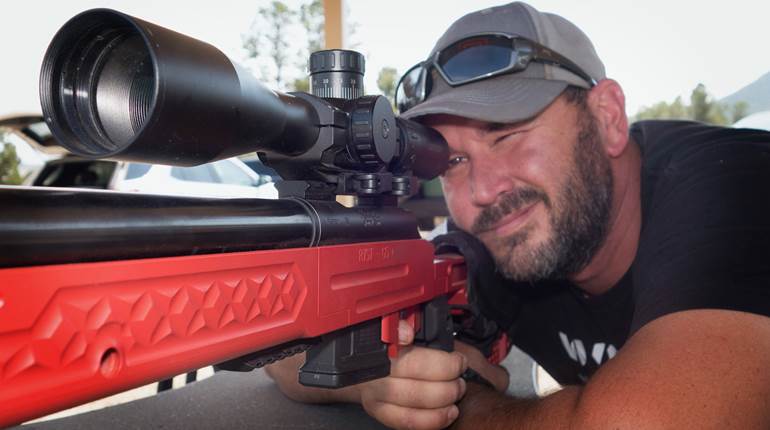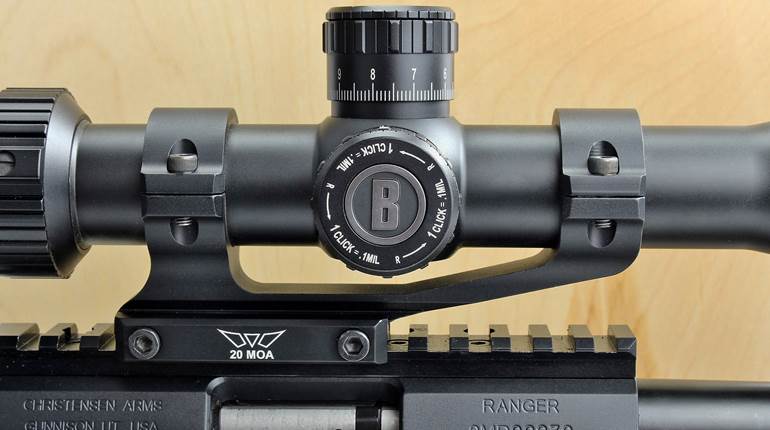
Long-range shooting usually starts out as something “cool” to try at the range. The inevitability of competition, even against ourselves, drives us to want to see just what we’re capable of-and then go farther. The first round successfully placed on target at distances well over 100 yards is truly something memorable.
Engaging targets at long range requires more than just a passing desire to lob lead, and is the culmination of a host of factors-many of which are within our control as shooters. What stands between us and the improvement of our long-range shooting skills is practice; more specifically, proper practice. In today's economy, this is often easier said than done. Prices have risen on everything from the firearms themselves, to the ammunition they eat. Practice costs, so we do what we must to make the most of it. Still, the allure of shooting at distances creeping up to and passing the 1,000-yard line can make even the most frugal of shooters start dropping some serious cash on range trips.
In my case, the round of choice for general distance shooting between 250 and 600 yards and further is the .308/7.62x51 NATO. Years of research have been put into perfecting the round itself, and both the United States Army and Marine Corps have employed the round in combat operations worldwide. The .308 has a proven pedigree, and is downright fun to shoot-especially at long range. These facts, coupled with the numerous loads available from the major ammunition manufacturers, make it an excellent cartridge for distance shooting regardless of experience level.
In the summer heat on the United States Marine Corps Base Quantico’s Range 4, it takes about 1.5 seconds for a .308 round to travel 600 yards. This also allows the shooter to literally watch the round in flight-the round’s disruption of the air it passes through as it flies downrange. Of all the facets of distance shooting, this singular factor is by far my most enjoyable. What's not enjoyable is watching dollar signs stack up with every shot; less enjoyable still if you’re having difficulty bringing rounds onto target as distances increase. Even though the .308 is one of the most readily available cartridges, it is still not uncommon to see prices around $1 per round for mid-range loads and better. Barring an unlimited budget, those numbers add up fast. Fifty to upwards of 150 rounds fired can easily see $150 or even more depart from your pocketbook. With that kind of money spent, leaving the firing line feeling frustrated with your performance is perhaps the most de-motivational eventuality of firing at targets placed football fields away.
I wanted to end those days of frustration, but I didn’t have the financial means to justify spending hundreds of dollars on a skill I know to be perishable if not constantly practiced. So I set out on a quest to keep my long-distance shooting skills sharp without having to take a second job. I looked into reloading my own rounds and purchasing in bulk, but what I finally settled on took me in an entirely different direction, and seemed counter intuitive-I decided to buy another rifle.
I created a distance training platform, and decided that my investment would be one that mirrored the fit, finish, feel and relative performance of my Ruger Gunsite Scout in .308 Win. with Hi-Lux 2-7x32 LER glass riding atop as closely as possible. I wanted to practice, but I also wanted to be able to eat at the end of the day. I wanted to be able to practice trigger press, wind gauging, breathing control, bolt operation and the rifle fundamentals in a manner that were scalable to my larger caliber. I wanted to concentrate on all of those things I knew needed improvement before I could truly begin to see just how well that Ruger could perform. I set my ideal corresponding target ranges between 300 and 400 yards-long enough to make for some really challenging shots, yet short enough that even on a bad day, rounds are still finding the target.
Obviously, buying another .308 wouldn’t solve my problem, I needed to find another caliber-one that would have performance scalable to the .308, but was much more affordable. I wanted to put together the entire package-rifle, optic and a good amount of “starter” ammunition-for under $450. After some hemming and hawing over the details, I settled on the .22 Long Rifle. Ammunition is cheaper and, save for the recent shortages that seem to abating, somewhat plentiful. With it set up to fire at a range between 100 and 200 yards, though not perfectly scalable to the .308, it was the best choice given my parameters. There are numerous .22 rifles that would have fit the bill, but I chose the Mk-II FV-SR; a 16.5 inch, 1/2x28 threaded-barrel bolt gun introduced by Savage as a “tactical trainer.” An oversized, heavy bolt handle gives the operation of the rifle the feel of something much larger. MSRP is currently at $260-I obtained mine for $225.
I outfitted the Savage with glass from Konus-Pro, selecting the 2-7x32 model 7260 optic. It commands an MSRP of $139.99, but is often available around the $75 mark. For the purposes of my project, it was the perfect fit. I also added a generic, multi-position bipod, as well as a spare A2-style flash hider, bringing my total investment to right around $320, leaving more than $100 for the purchase of ammunition. I bought a little bit of everything, from Remington and Winchester bulk packs, to CCI and Wolf “match” .22 Long Rifle cartridges. All told, I came home with over 1,700 rounds of ammunition, and still hadn’t hit my $450 limit.
The .22 round can’t be called a direct comparison to the .308 by any means, but its performance at several pre-determined distances can be invaluable at practicing for corresponding longer ranges. The bulk of my .22 shooting was done with 40-grain bullets, while my .308s were primarily 175 grain. What I found on the range comparing the two rifles and rounds was staggeringly quantifiable in one very specific and valuable sense.
In terms of horizontal bullet drift, the smaller size and rounder nose of a .22 bullet, coupled with the lower muzzle velocities delivered by the round, amplified the impact of wind on my shots. I measured drift at various ranges, and then performed the same measurements with the .308. I found that between the two rifles, there exists an approximate scalability of half the range of the .308 minus 30 yards (shooting 100 yards on the .22 equals shooting 230 yards on the .308). The drift measurements I obtained while shooting the .22 at 100 yards in a 10 mph right-to-left crosswind were nearly identical to those I obtained at 230 yards with the .308. The .22 consistently shifted between 3.7 and 3.9 inches point-of-aim to point-of-impact, and the .308 consistently shifted between 3.5 and 3.6 inches. Pushing the distances out further, the .22 began to show significant wind impact past 150 yards. Still, the scalability factor (Range in yards multiplied by 2 plus 30 yards) held up. At 150 yards, I noted an average drift of just over 8 inches for the .22; the .308 at 330 yards gave similar results, with point-of-impact group averages drifting 7.9 inches from point-of-aim. Pushing to my maximum desired range of 200 yards, the drift measurements with the .22 were between 14 and 14.5 inches, while the .308 consistently marked at 14.6 inches or less when shot at 430 yards. Shooting the .22 in the wind is a blast, especially after realizing the drift compensations needed for various distances in various crosswinds. A few hundred rounds of.22 and my performance at the corresponding distances on the .308 improved markedly. It seems I’m not alone in my desire to find a way to improve shooting with the .308 using a .22 rifle; an entire rimfire shooting competition has developed in California around the same premise, with remarkably similar results.
The sheer affordability of .22 ammunition has translated to a huge increase in trigger time, which has enabled me to concentrate on the fundamentals of shooting. I can put 500 rounds of .22 into my range bag for under $25, while shooting the same amount of 145-grain military-surplus 7.62x51 rounds will push past the total investment I have so far into this .22 training rifle. While there’s no true substitute for practicing with the .308, the ability to focus on follow-up shots, breathing control, smooth trigger press and other caliber-unspecific nuances of rifle shooting allows me to step behind the glass on the .308 with confidence in my abilities, and clear goals for what limited ammunition I may have to expend. I have significantly reduced the frequency of finding myself frustrated while trying to dial in the .308 on long-range targets.
My initial goal was to create a training platform specific to my .308; range time proved that except for the basics of rifle-shooting, the only truly applicable carry-over between my trainer and its larger brother was wind-gauging practice. I intended to add this Savage to my safe as an “every now and then” rifle; the one you grab when you’re not sure what you want to shoot, you just know you want to shoot. Instead, I’ve created a rifle that I never leave home without. Even on days when I plan to focus solely on handgunning, the Savage case finds its way into my truck, along with a box of .22. As this project came to a close, I decided to make another investment in the Savage. I replaced the factory black-synthetic stock with a Boyd’s Rimfire Hunter laminate stock in Pepper, an under $100 investment that drastically improved the look and feel of the rifle. Had I added this stock at the beginning of the project, I still would have been left with enough room in my budget for nearly 1,000 rounds of .22 ammunition.
Distance shooting can be had while staying on a budget. While you won’t find a way to completely replace trigger-time on the larger and more expensive calibers, you may just find that the added practice you’re now able to afford greatly increases your abilities as a rifleman in general. You won’t find yourself shooting 1,000 yards overnight, but you’ll catch yourself learning the skills that later add up to being able to consistently settle in behind the glass, take aim toward the horizon and press the trigger with confidence that your round will find its target.






































